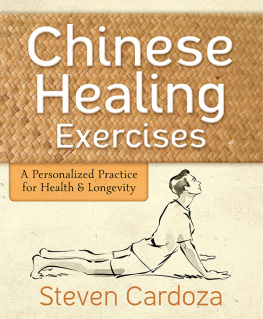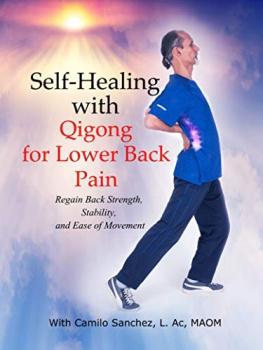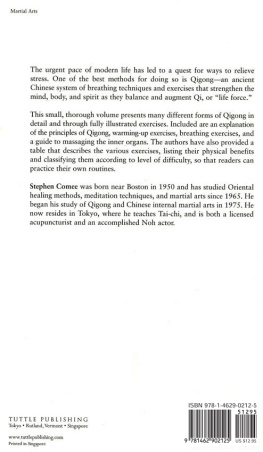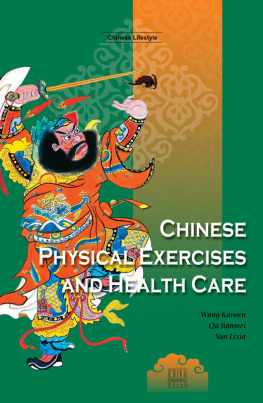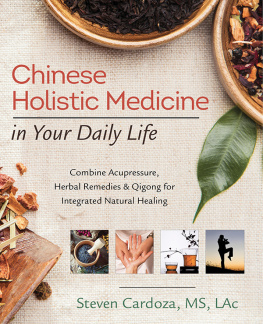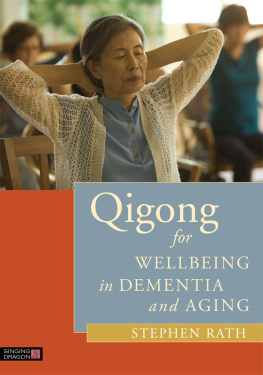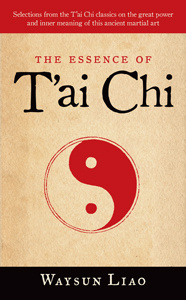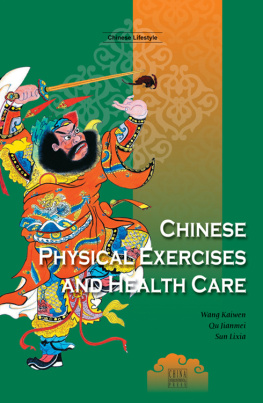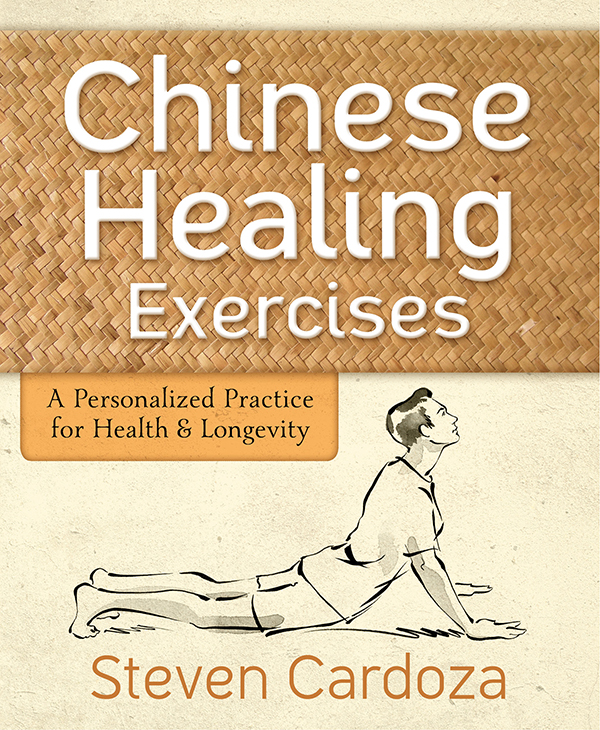Steven Cardoza has a master of science degree in Traditional Chinese Medicine, 1994 (from the American College of TCM, San Francisco). An alternative health provider since 1985 and a practicing Chinese medical physician (acupuncture, Chinese herbs, therapeutic bodywork, medical qigong, etc.) since 1995, he is nationally certified and licensed in California and Massachusetts. Steven holds numerous certifications in many styles of qigong and Wu taiji from living Daoist lineage holder Master B. K. Frantizis.
Llewellyn Publications
Woodbury, Minnesota
Copyright Information
Chinese Healing Exercises: A Personalized Practice for Health & Longevity 2013 by Steven Cardoza.
All rights reserved. No part of this book may be used or reproduced in any matter whatsoever, including Internet usage, without written permission from Llewellyn Publications, except in the form of brief quotations embodied in critical articles and reviews.
As the purchaser of this e-book, you are granted the non-exclusive, non-transferable right to access and read the text of this e-book on screen. The text may not be otherwise reproduced, transmitted, downloaded, or recorded on any other storage device in any form or by any means.
Any unauthorized usage of the text without express written permission of the publisher is a violation of the authors copyright and is illegal and punishable by law.
First e-book edition 2013
E-book ISBN: 9780738738895
Book design by Bob Gaul
Cover illustration by Katherine Asher/Illustration Ltd.
Cover design by Lisa Novak
Editing by Laura Graves
Interior illustrations by Mary Ann Zapalac
Disclaimer
This book is not intended to diagnose, treat, or cure any medical condition. The reader assumes all responsibility for practicing any exercise presented in this book. Consult your medical professional before beginning any new fitness regimen or if you have a medical condition.
Llewellyn Publications is an imprint of Llewellyn Worldwide Ltd.
Llewellyn Publications does not participate in, endorse, or have any authority or responsibility concerning private business arrangements between our authors and the public.
Any Internet references contained in this work are current at publication time, but the publisher cannot guarantee that a specific reference will continue or be maintained. Please refer to the publishers website for links to current author websites.
Llewellyn Publications
Llewellyn Worldwide Ltd.
2143 Wooddale Drive
Woodbury, MN 55125
www.llewellyn.com
Manufactured in the United States of America
Contents
Toe Pinch, Stretch, and Twist
Toe Stretch, Forward and Backward
Toe Stretch, Side to Side
Rotational Toe Stretch
Rotational Foot and Ankle Stretch
Foot Wringing, Upward
Foot Wringing, Downward
Centerline of Sole Massage
Centerline Fold and Spread
Palm Rub, Laogong to Yongquan (Bubbling Well)
Pumping the Bubbling Well Point
Ankle Flexion and Extension
Ankle Pronation and Supination (Inward and Outward Foot Roll)
Ankle Rotations
Kneeling Toe Stretch
Tapping and Patting the Outter Legs (Yang surfaces)
Tapping and Patting the Inner Legs (Yin surfaces)
One-Leg Hamstring Stretch
Two-Leg Hamstring Stretch
Seated Split
Hip Rotator Stretch
Back Rock and Roll
Quadriceps Stretch
Standing Ankle Stretches
Back of Ankle/Achilles Tendon Stretch
Knee Rotations
Flex and Extend Fingers
Backward Finger Extension and Stretch
Shake Out Fingers, Hands, and Arms
Wrist Rolls
Shoulder Rolls
Shoulder Shrug and Drop
Shoulder Blade Protraction and Retraction with Arm Rotation
Hand Over Shoulder Stretch
Whole Arm Tap and Pat
Breast Stroke for the Shoulders
Shoulder/Arm Windmills
Full Arm Rotation for Elbow and Shoulderblades
Kneeling Forearm Stretch
Prayer Hands Behind Back
Interlocking Fingers behind BackA Shoulder Stretch
Nerve and Meridian Stretch/Release
Torso Twist with Arm Swing
Pelvic Tilt (Forward and Back)
> Hula Rolls
Yin-Yang Side Bend
Lateral Swimming Dragon
Standing Toe Touch, Legs Together
Opposite Leg Toe Touch, the Whole Body Windmill
Seated Torso Twist
Lying Du Meridian Back Extension
Flex and Extend
Turtle
Crane
Side to Side
Lateral Flexion
Chin to Chest Neck Rotation
Thumb Massage to Back of Neck
Resistance Exercises
-Forward Resistance
-Rearward Resistance
-Lateral/Sideways Resistance
-Rotational Resistance
Scalp Rake
Temple Massage
Ten Point Eye Acupressure Massage
Four Directions Eye Exercise
4A. Eye Focus Exercise
Eye Cupping
Beating the Heavenly Drum
Ear Pop
Friction Massage to Sides of the Nose
Seven Point Nasal Acupressure Massage
Teeth Clicking and Tapping
Tongue Circles the Teeth/Red Dragon Dances
Saliva Swish and Swallow
Face Wash and Wipe Down
Pineal Tap
Pituitary and Hypothalamus Tap
Thyroid Massage
Thymus Tap
Kidney/Adrenal Tap
Kidney Massage
For Men OnlyProstate Massage
For Women OnlyBreast Massage
The Physical Practice
The Energetic Practice
Beginning a Practice Session: Whole Body Vibration
Waking the Qi: Dragon Playing with a Pearl
Ending a Practice Session: Running the Meridians
Qi Storage at the Dantian
Follow Your Breath Meditation
Standing Practice
A special thank-you to Michael Shear for his generosity of time
and expertise in providing all the photographs that were used as the basis
for the illustrations found throughout the book.
Authors Note
The Chinese understanding of the organs within the body contains, for the most part, the Western understanding of those organs. For example, they of course know that a pair of lungs are located in the chest, that they open to the nose and mouth, and their function is to bring air into the body, extract atmospheric oxygen for use within the body, and expel carbon dioxide as a waste product, exchanging those gasses with the blood circulatory system through tiny blood vessels surrounding the alveolar membrane deep within the lungs. Since the Chinese medical view also contains the concept of qi, a tangible if very subtle manifestation of vital life energy, there is necessarily an expanded view of the function of each organ beyond what Western medical science currently acknowledges, and other concomitants such as related meridian pathways for the transport of the qi of each organ through well-defined trajectories which also have their unique characteristics and special affinities between an organ and a specific body tissue. The Lungs have a special affinity for the skin. It is very common for someone with childhood asthma to develop eczema or psoriasis a little later in life, an observation that is one clear demonstration of that connection when viewed through the lens of Chinese medicine.
As the observant reader will see in the preceding paragraph, when I first mentioned the lungs, I used a lowercase l . Later, when referring to the Chinese concept of Lungs, I used a capital L . This is a typical convention used in many English language books about Chinese medicine, and one I will attempt to faithfully follow in this book. When the common Western understanding of an organ is being referred to, I will use lower case, but when referring to the expanded Chinese medical understanding, I will use an upper case designation. My intention here is to alert the reader to the distinction, especially for readers who may only be familiar with the Western perspective and may otherwise become confused when reading, as in the previous example, that the lungs have a special relationship with the skin.

